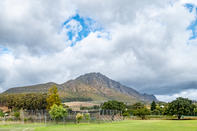Academics and Sports
The rectors of Paul Roos Gymnasium through the years since the departure of its namesake have guided the school unerringly along a path of sporting and academic excellence.

Under Mr AK de Jager the official school uniform came into being, and enrolment rose so dramatically that extensive additions had to be built onto the new complex; also, the sports grounds and other facilities took shape and, finally, for the first time in nearly a century, one of the country's foremost rugby schools had its own fields.
Mr GJA Smit saw the school reach a capacity enrolment of 900 pupils. Mr DJ de Villiers was followed by Mr JC Coetzee, who left to take up a lecturing post at the university.
During the tenure of Mr JD Slabbert the control of the school changed quite drastically, with the university council ceding in favour of the parents its right to select the school committee; on a more concrete note, Old Boy and Rhodes Scholar Piet Koomhof, a former minister of sport and ambassador to the United States, officially opened the Markotter Sports Complex, named after AF 'Mr Mark' Markotter, Old Boy, advocate, member of the university council and inspired mentor to Stellenbosch and Springbok rugby players of many generations.
While its rugby achievements are the school's greatest pride, it has never neglected its academic role. It was for this reason that Cecil John Rhodes chose the Stellenbosch Boys' High School as one of only four schools in what was then the British Empire to be entitled to award an annual Rhodes Scholarship to its most deserving all-rounder.
The first Stellenbosch recipient of this was William Miller MacMillan in 1903, and in its centenary year of 1991 the prize went to Fanie du Toit. DM Claassen won the coveted prize in 1992, and Stadler Trengove in 1993.
Milne to Malan
It was during the second head of the school, Mr Milne's time that the first hostel for pupils, Het Te Huis ('The Home'), was opened. While today the hostels play a central role in the life of the school, it seems that conditions in their formative years were a little on the primitive side.
It was also during Milne's time that the foundations of what would eventually become Stellenbosch University were laid. In 1874 the school had established an Arts Department, which elevated it to the status of a college. Seven years later this Arts Department separated from the school, although the two bodies remained linked by the college council.
In 1886 the name Stellenbosch College was suggested for the Arts Department, but this was changed to Victoria College the following year, to commemorate Queen Victoria's jubilee year. Victoria College became the University of Stellenbosch in 1918. Milne's untimely death marked the beginning of an era of South African rectors, the first being the brilliant Dr JF Marais, who took up the office in 1896.
Marais, a friendly man with a genial nature, met the challenge head-on, and it was a great loss to the school when he drowned in 1901. The school library, established in the same year, was named after him. Mr WH Hofmeyr took over the reins in 1902, and it is thanks mainly to Hofmeyr that Paul Roos Gymnasium today has such a strong and healthy school spirit, as he made it his aim to engender this during his tenure.
By David Bristow Stellenbosch is undoubtedly one of the prettiest little towns in South Africa, founded in 1679 and the second oldest town in the country. Th...
Stellenbosch is undoubtedly one of the prettiest little towns in South Africa, founded in 1679 and the second oldest town in the country. Th...